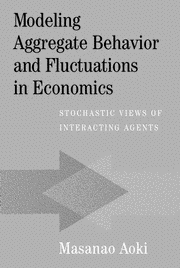Book contents
- Frontmatter
- Contents
- Preface
- 1 Overviews
- 2 Setting Up Dynamic Models
- 3 The Master Equation
- 4 Introductory Simple and Simplified Models
- 5 Aggregate Dynamics and Fluctuations of Simple Models
- 6 Evaluating Alternatives
- 7 Solving Nonstationary Master Equations
- 8 Growth and Fluctuations
- 9 A New Look at the Diamond Search Model
- 10 Interaction Patterns and Cluster Size Distributions
- 11 Share Market with Two Dominant Groups of Traders
- Appendix
- References
- Index
4 - Introductory Simple and Simplified Models
Published online by Cambridge University Press: 15 October 2009
- Frontmatter
- Contents
- Preface
- 1 Overviews
- 2 Setting Up Dynamic Models
- 3 The Master Equation
- 4 Introductory Simple and Simplified Models
- 5 Aggregate Dynamics and Fluctuations of Simple Models
- 6 Evaluating Alternatives
- 7 Solving Nonstationary Master Equations
- 8 Growth and Fluctuations
- 9 A New Look at the Diamond Search Model
- 10 Interaction Patterns and Cluster Size Distributions
- 11 Share Market with Two Dominant Groups of Traders
- Appendix
- References
- Index
Summary
This chapter collects some solved examples of simple or simplified models, which are developed more fully later in this book. The first example describes a simplified two-sector version of a K-sector model with underutilized factors of production. As a starter we just describe its equilibrium distributions. Later, in Chapter 8, we discuss dynamics of equilibria and a general K-sector version. The rest of the examples illustrate how to solve master equations. In these examples, agents choose one of a discrete set of choices or decisions. We classify agents by their decisions or the algorithms they are using into distinct classes, or types. When the total number of agents is fixed, we speak of closed models, that is, closed to entry or exit by agents. When there are random entries and exits, we have open models, in which the number of agents is a random variable. When agents have two alternative decisions (algorithms or choices), we speak of binary choice or binary decision models. Such models are perhaps the simplest for a large group of microeconomic agents, and are suitable to illustrate a number of points that we wish to make.
A two-sector model of fluctuations
This model is a simplified two-sector version of a more general model of an economy composed of K-sectors (agents), which is similar to the one described more fully in Section 8.6. Here, for simplicity, we assume that the two sectors produce identical or close-substitute goods.
Information
- Type
- Chapter
- Information
- Modeling Aggregate Behavior and Fluctuations in EconomicsStochastic Views of Interacting Agents, pp. 27 - 40Publisher: Cambridge University PressPrint publication year: 2001
